The crystal-clear waters surrounding Hawaii are a haven for a remarkable variety of whale species. There are roughly 27 different species, to be specific, of whales found in Hawaiian waters. A part of this figure includes a variety of dolphins. That’s right, scientifically speaking, all dolphins are, in fact, whales. But not all whales are dolphins. These marine mammals grace the Pacific Ocean with their presence.
Several locations offer excellent vantage points to maximize your chances of seeing these magnificent creatures. From land, popular spots for whale watching include Maui’s Lahaina Harbor, Oahu’s Makapu’u Point, and Kauai’s Spouting Horn. If you prefer a closer encounter, guided boat tours departing from various Hawaiian harbors provide an immersive experience with these incredible marine mammals.
Always remember to respect the animals’ space and follow responsible whale-watching guidelines. It is crucial to respect the well-being of these animals and the conservation efforts in place to protect them.
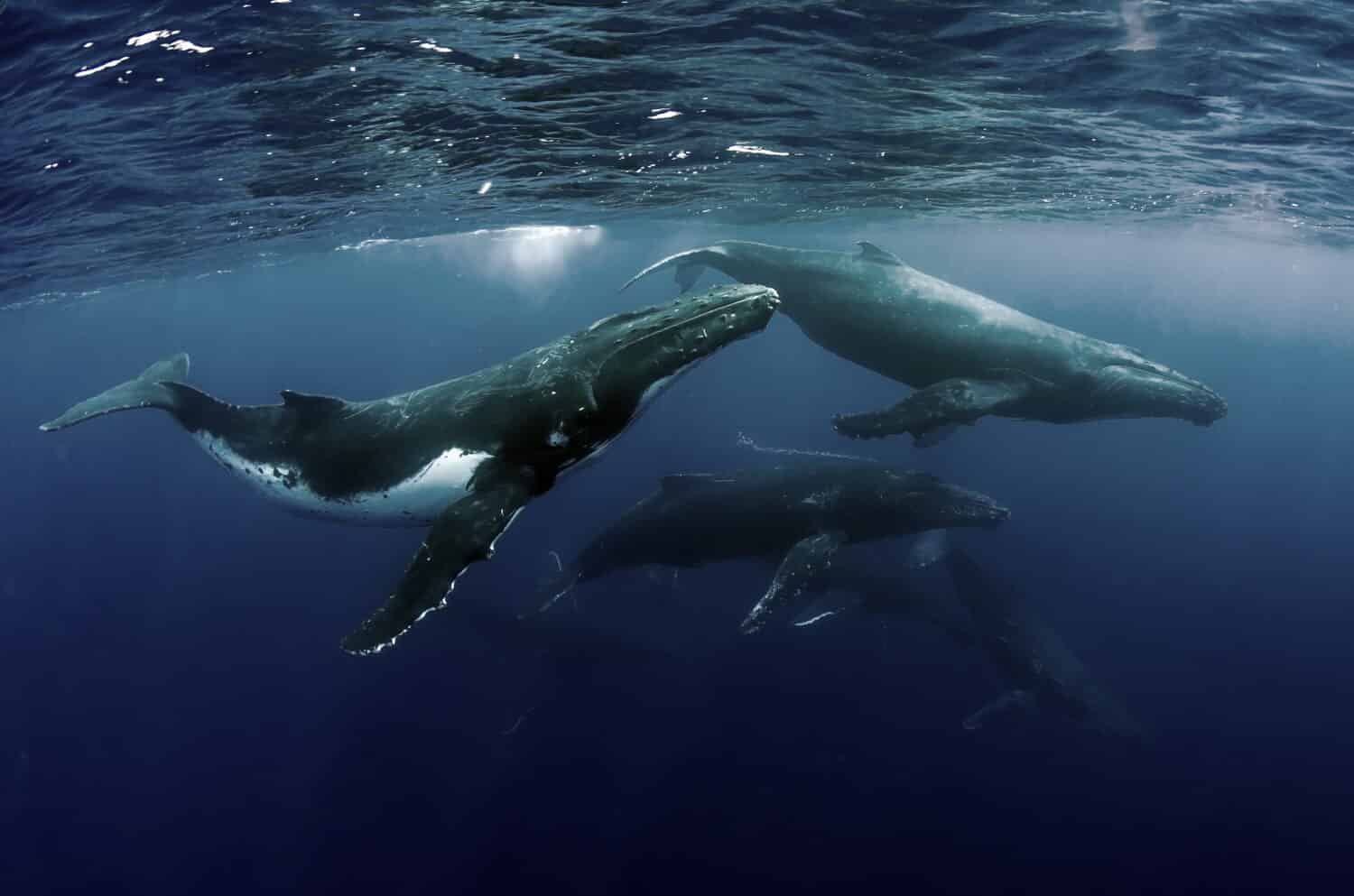
Humpback whales are a common sight in Hawaiian waters.
©Tomas Kotouc/Shutterstock.com
27 Whales Found in Hawaiian Waters
| Whale Species | Sightings |
|---|---|
| Humpback whales (Megaptera novaeangliae) | Most Common |
| Short-finned pilot whales (Globicephala macrorhynchus) | Most Common |
| Bottlenose dolphins (Tursiops truncatus) | Most Common |
| Pantropical spotted dolphins (Stenella attenuata) | Most Common |
| Spinner dolphins (Stenella longirostris) | Most Common |
| Rough-toothed dolphins (Steno bredanensis) | Most Common |
| Dwarf sperm whales (Kogia sima) | Common |
| Cuvier’s beaked whales (Ziphius cavirostris) | Common |
| False killer whales (Pseudorca crassidens) | Common |
| Melon headed whales (Peponocephala electra) | Common |
| Sperm whales (Physeter macrocephalus) | Less Common |
| Pygmy killer whales (Feresa attenuata) | Less Common |
| Blainville beaked whales (Mesoplodon densirostris) | Less Common |
| Striped dolphins (Stenella coeruleoalba) | Less Common |
| Risso’s dolphins (Grampus griseus) | Less Common |
| Orca whales or killer whales (Orcinus orca) | Rare |
| Sei whales (Balaenoptera borealis) | Rare |
| Fin whales (Balaenoptera physalus) | Rare |
| Minke whales (Balaenoptera acutorostrata) | Rare |
| Bryde’s whales (Balaenoptera brydei) | Rare |
| Blue whales (Balaenoptera musculus) | Rare |
| Gray whales (Eschrichtius robustus) | Rare |
| Pygmy sperm whales (Kogia breviceps) | Rare |
| North Pacific right whales (Eubalaena japonica) | Rare |
| Cross seamount beaked whales (Mesoplodon traversii) | Rare |
| Longman’s beaked whales (Indopacetus pacificus) | Rare |
| Fraser’s dolphins (Lagenodelphis hosei) | Rare |
Aside from our list of 27 whales found in Hawaiian waters, let’s explore the top six most commonly sighted whales.
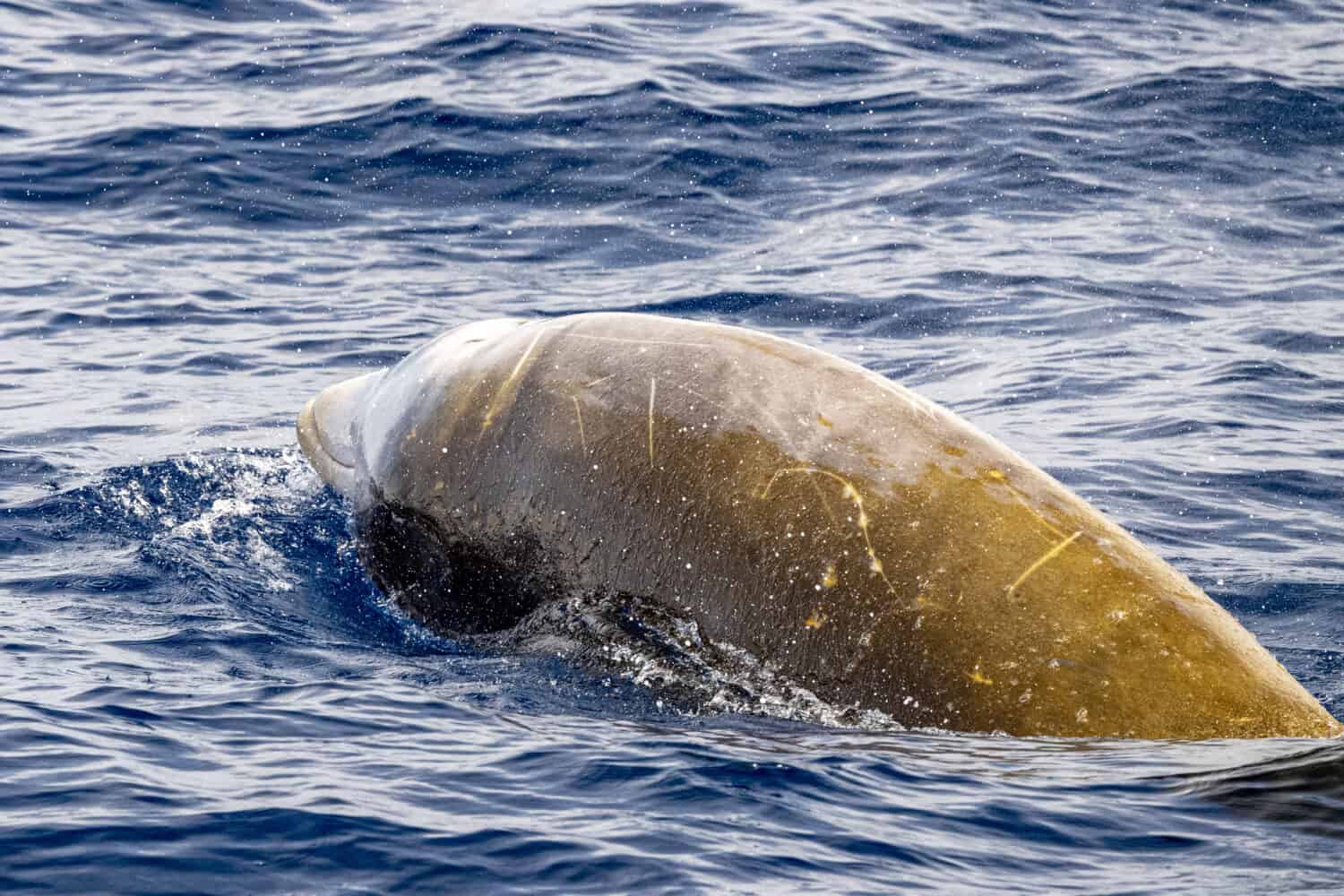
Though not exceedingly common, Cuvier’s beaked whales can be found in Hawaiian waters.
©Andrea Izzotti/Shutterstock.com
Humpback Whales (Megaptera novaeangliae)
Adult humpback whales are impressively large. On average, adult males reach lengths of about 45 feet, while adult females measure slightly larger, at upwards of 55 feet. These magnificent creatures showcase a streamlined body with long pectoral fins and a distinctive hump on their backs, giving them their name. Their tails, or flukes, are wide and powerful, aiding them in their magnificent displays of breaching and tail-slapping.
In terms of conservation status, humpback whales are considered a conservation success story. Previously listed as endangered, their population has shown a significant recovery since implementing protective measures. Currently, they are listed as a species of “least concern” by the International Union for Conservation of Nature (IUCN). However, ongoing conservation efforts are essential to ensure their continued recovery and safeguard their habitat.
Humpback whales hold a special place in Hawaiian culture and history. They are deeply respected and honored as spiritual beings known as koholā. The connection between humpback whales and the people of Hawaii is celebrated through cultural events, festivals, and traditional practices. The presence of these magnificent creatures in Hawaiian waters is a natural wonder and a cultural legacy that strengthens the bond between humans and the natural world.
When and Where to See Humpback Whales in Hawaii
You can find Humpback whales in Hawaiian waters during their annual migration, typically from November to May. These gentle giants embark on a long journey from their feeding grounds in Alaska to the warm Hawaiian waters for breeding and calving. The peak season for sightings is from January to March, with the highest population. The whales come to these tropical waters to find mates, give birth to their young, and nurture them in a safe and nutrient-rich environment.
You can spot Humpback whales in various locations around the Hawaiian Islands. Maui’s shallow and protected waters, particularly the areas around Lahaina and Maalaea Bay, are renowned for their frequent whale sightings. Other popular locations include Oahu’s North Shore, Kauai’s Na Pali Coast, and the Big Island’s Kona Coast. These regions offer ideal conditions for the whales, providing abundant food sources and sheltered areas for breeding and calving.
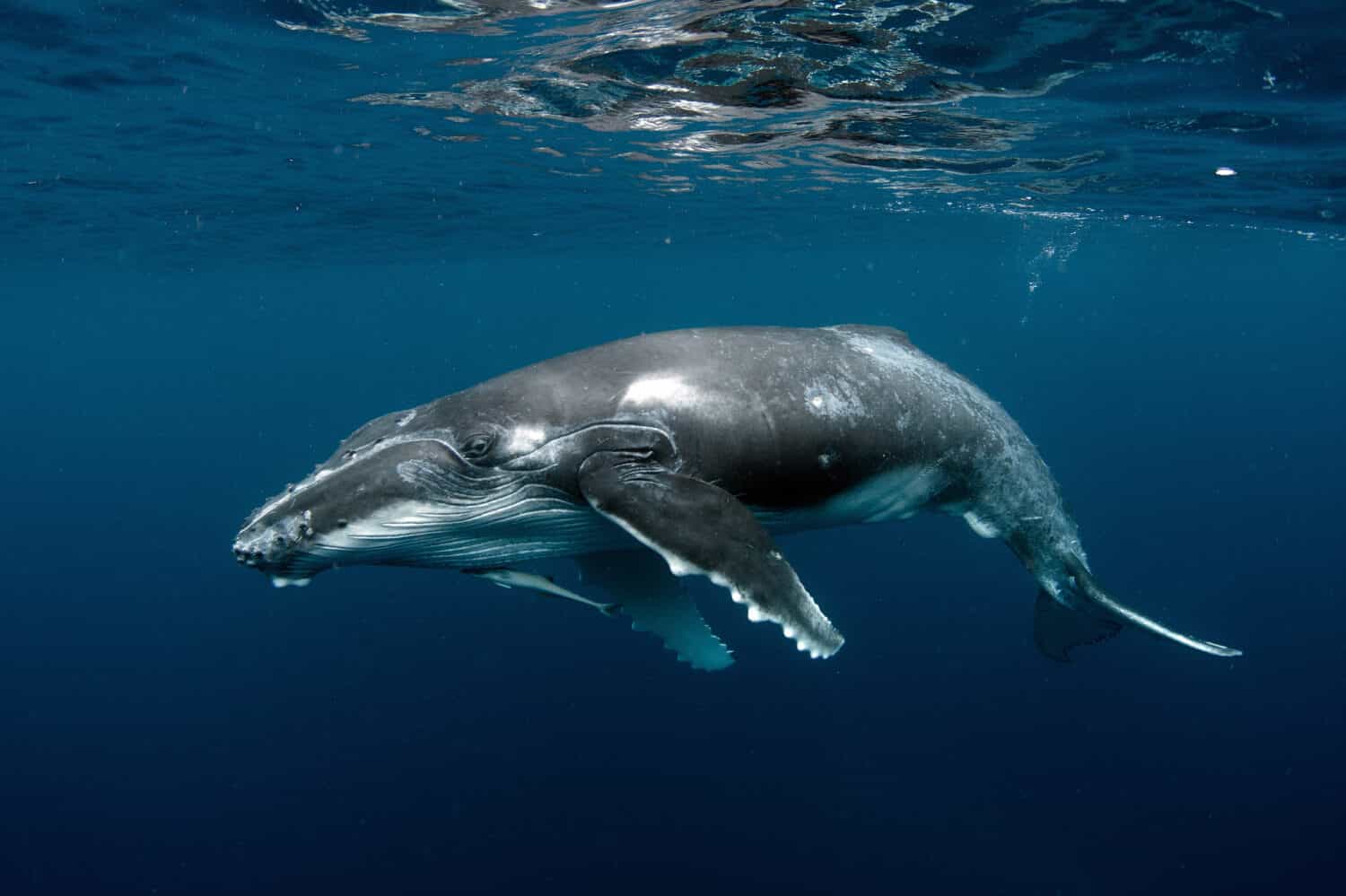
Humpback whales migrate to Hawaiian waters for breeding and calving.
©Tomas Kotouc/Shutterstock.com
Short-Finned Pilot Whales (Globicephala macrorhynchus)
Adult short-finned pilot whales have an average length of around 9 to 20 feet, with males slightly larger than females. They exhibit a robust and streamlined body with a dark gray to black coloration. These whales have a prominent, bulbous head with a well-defined melon, giving them a distinctive appearance.
Short-finned pilot whales are highly social animals with strong familial bonds. They live in tight-knit groups called pods, consisting of several individuals. These pods exhibit complex social structures and engage in cooperative behaviors, such as hunting and raising their young.
Regarding conservation status, short-finned pilot whales are listed as a species of “least concern” by the IUCN. However, like all marine species, they face potential threats such as entanglement in fishing gear, pollution, and habitat degradation. Continued monitoring and conservation efforts are crucial to protect their population and ensure the health of their marine habitat.
While short-finned pilot whales’ presence adds to the region’s rich marine life, observing these enigmatic creatures in their natural habitat provides a unique opportunity to appreciate the diverse wonders that grace the Hawaiian seas.
When and Where to See Short-finned Pilot Whales in Hawaii
Short-finned pilot whales are year-round residential species of Hawaiian waters. However, you are most likely to spot them during the summer months, from May to October. These intelligent and social animals often travel in tight-knit pods, making them easier to spot. They frequent the island’s shorelines due to the abundant food sources and favorable environmental conditions. The warm waters provide ample prey, including squid and fish, which sustains their population.
You can find these whales in various locations around the Hawaiian Islands. They prefer to inhabit deeper offshore waters but can occasionally be spotted closer to the islands, particularly along Kauai, Oahu, Maui, and the Big Island coastlines. Overall, they have a preference for deeper waters.
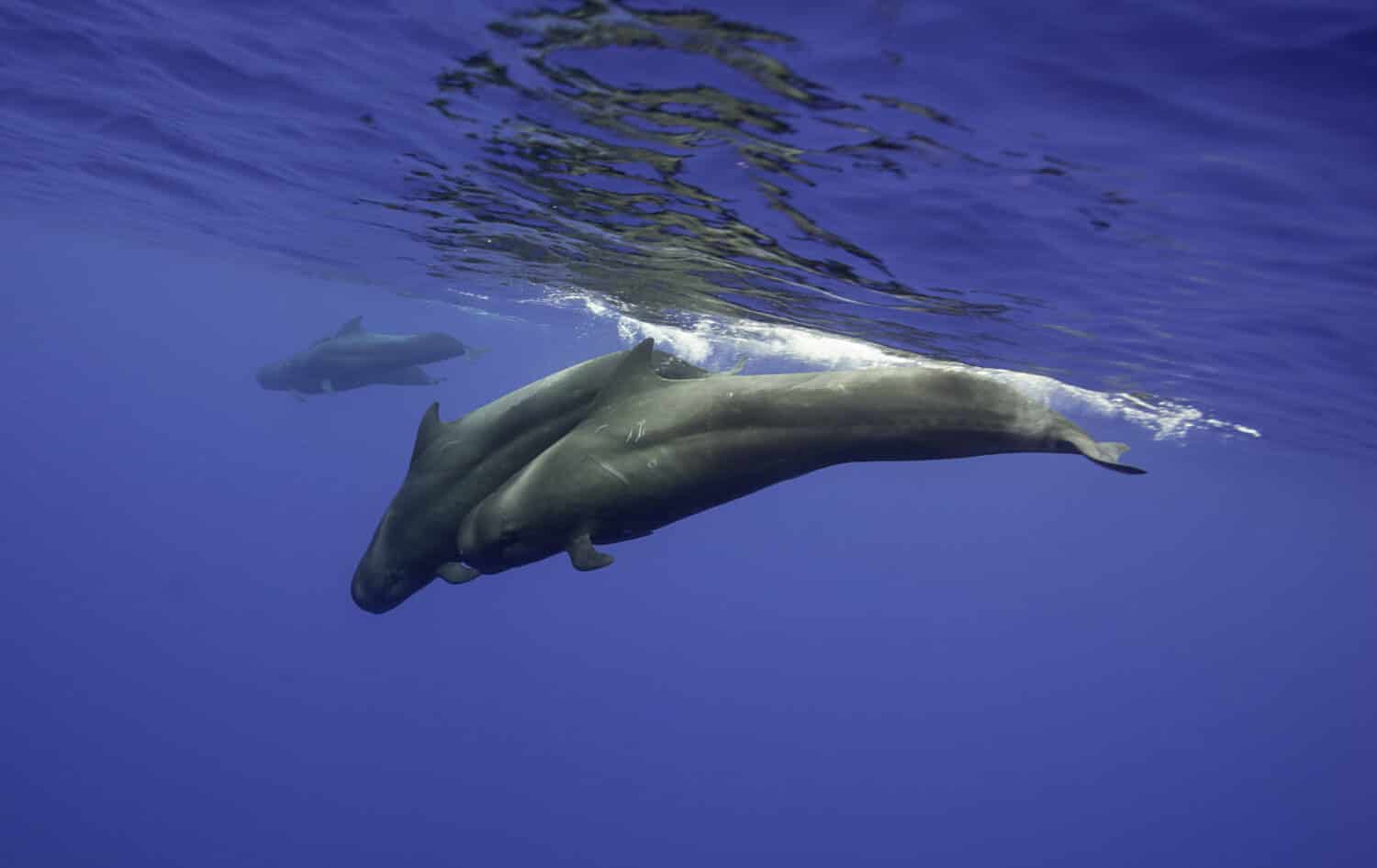
Short-finned pilot whales are highly social animals.
©wildestanimal/Shutterstock.com
Bottlenose Dolphins (Tursiops truncates)
Adult bottlenose dolphins have an average length of about 6 to 13 feet, with males typically larger than females. They possess a streamlined body, a prominent dorsal fin, and a characteristic “bottle-shaped” rostrum, from which their name is derived. Their sleek and muscular bodies allow them to move swiftly through the water.
Bottlenose dolphins are highly intelligent and social animals. Like many dolphins, they have a playful behavior, often seen leaping, riding waves, and engaging in acrobatic displays. These dolphins exhibit complex communication skills and form strong social bonds within their pods. Their remarkable cognitive abilities and adaptability contribute to their successful existence in various marine habitats.
In terms of conservation status, The IUCN lists them as a species of “least concern.” However, they still face threats such as habitat degradation, pollution, entanglement in fishing gear, and human disturbances. Protecting their habitats and promoting responsible marine tourism practices are essential for their long-term well-being.
Bottlenose dolphins hold a special place in the hearts of Hawaiians and visitors alike. Their playful nature and close interactions with humans have led to unique cultural connections and a deep appreciation for these incredible creatures.
When and Where to See Bottlenose Dolphins in Hawaii
Bottlenose dolphins inhabit Hawaiian waters throughout the year, making them a resident species. The warm tropical waters provide favorable conditions and abundant food sources, including fish and squid. They frequent coastal areas and nearshore habitats, often coming close to shorelines and providing delightful encounters for onlookers, particularly in the early morning or late afternoon.
You can find these dolphins in various locations around the Hawaiian Islands, with their presence spanning the coastlines of Maui, Oahu, Kauai, and the Big Island. They visit near rocky areas, bays, and offshore islands. Their adaptability allows them to thrive in diverse environments, from shallow reefs to deeper waters.
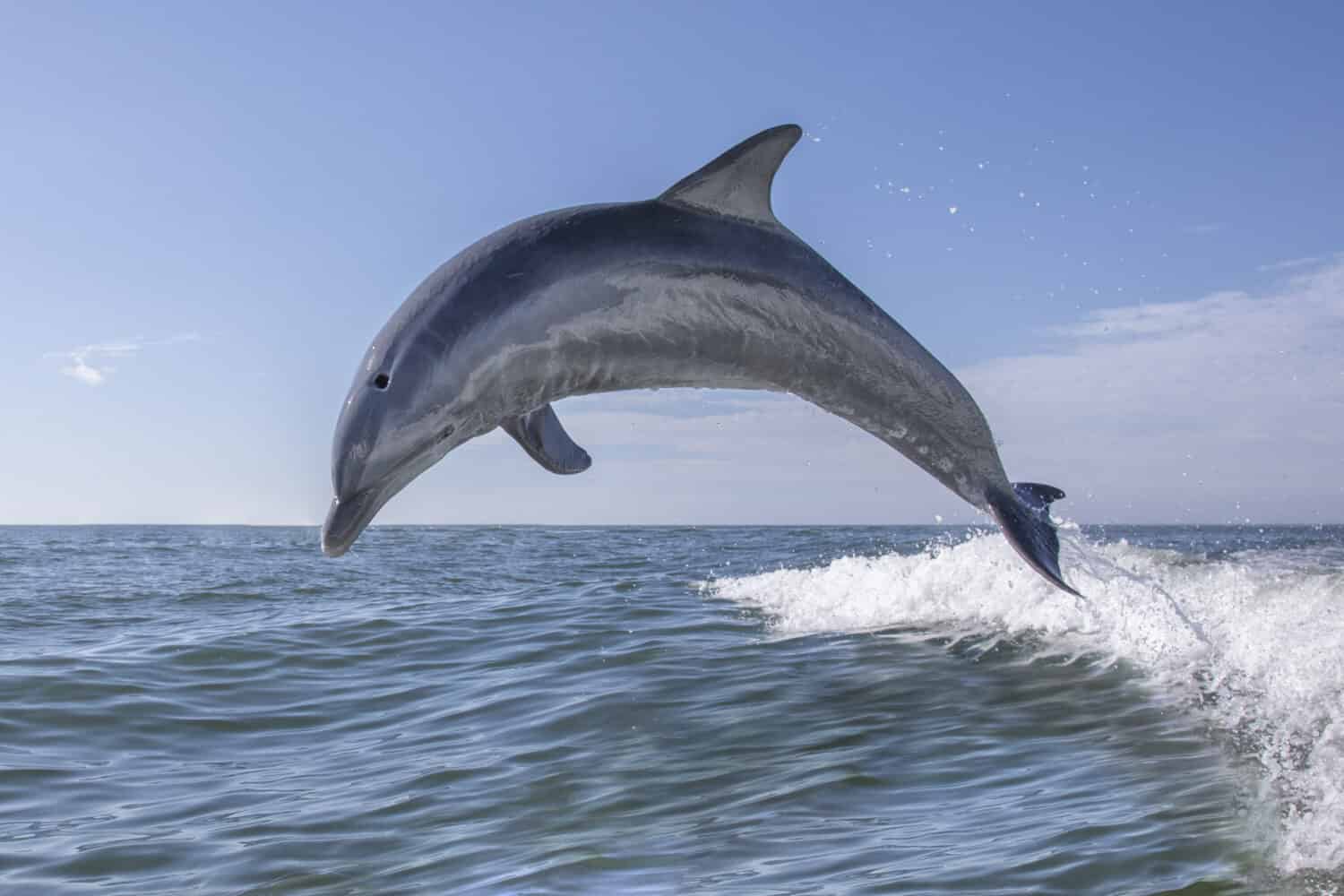
Bottlenose dolphins frequent coastal areas.
©Tory Kallman/Shutterstock.com
Pantropical Spotted Dolphin (Stenella attenuate)
The average adult male pantropical spotted dolphin measures around 6 to 8 feet in length, while adult females are slightly smaller. These dolphins exhibit a sleek and streamlined body with a dark gray or black coloration. Their most distinguishing feature is the spots adorning their bodies, which vary in size and pattern, adding a touch of unique beauty.
Pantropical spotted dolphins are another species of whales found in Hawaiian waters. They are highly social animals, forming cohesive groups and exhibiting strong bonds within their pods. They have a playful behavior, often seen riding the bow waves of boats, leaping, and engaging in synchronized swimming. These dolphins possess remarkable agility and can be seen performing aerial acrobatics.
In terms of conservation status, the IUCN lists pantropical spotted dolphins as a species of “least concern.” However, like all marine species, they face potential threats such as entanglement in fishing gear, habitat degradation, and disturbance caused by human activities. Protecting their habitats and implementing responsible fishing practices are essential for long-term survival.
Pantropical spotted dolphins hold a special place in the hearts of Hawaiians and visitors alike. Their lively presence and playful antics bring joy to all who witness them. The opportunity to observe these charismatic dolphins in the tropical waters of Hawaii is a true privilege.
When and Where to See Pantropical Spotted Dolphins in Hawaii
Pantropical spotted dolphins reside in Hawaiian waters throughout the year, making them a resident species in the region. The warm tropical climate and the abundance of food sources attract these dolphins to the Hawaiian waters. They come to coastal and offshore areas to forage, socialize, and raise their young.
You can encounter these dolphins in various locations around the Hawaiian Islands, particularly in deeper offshore waters near oceanic banks and ledges. You are likely to spot them playing and traveling in groups, showcasing their energetic and acrobatic behavior. Pantropical spotted dolphins often form larger groups, ranging from dozens to hundreds of individuals.
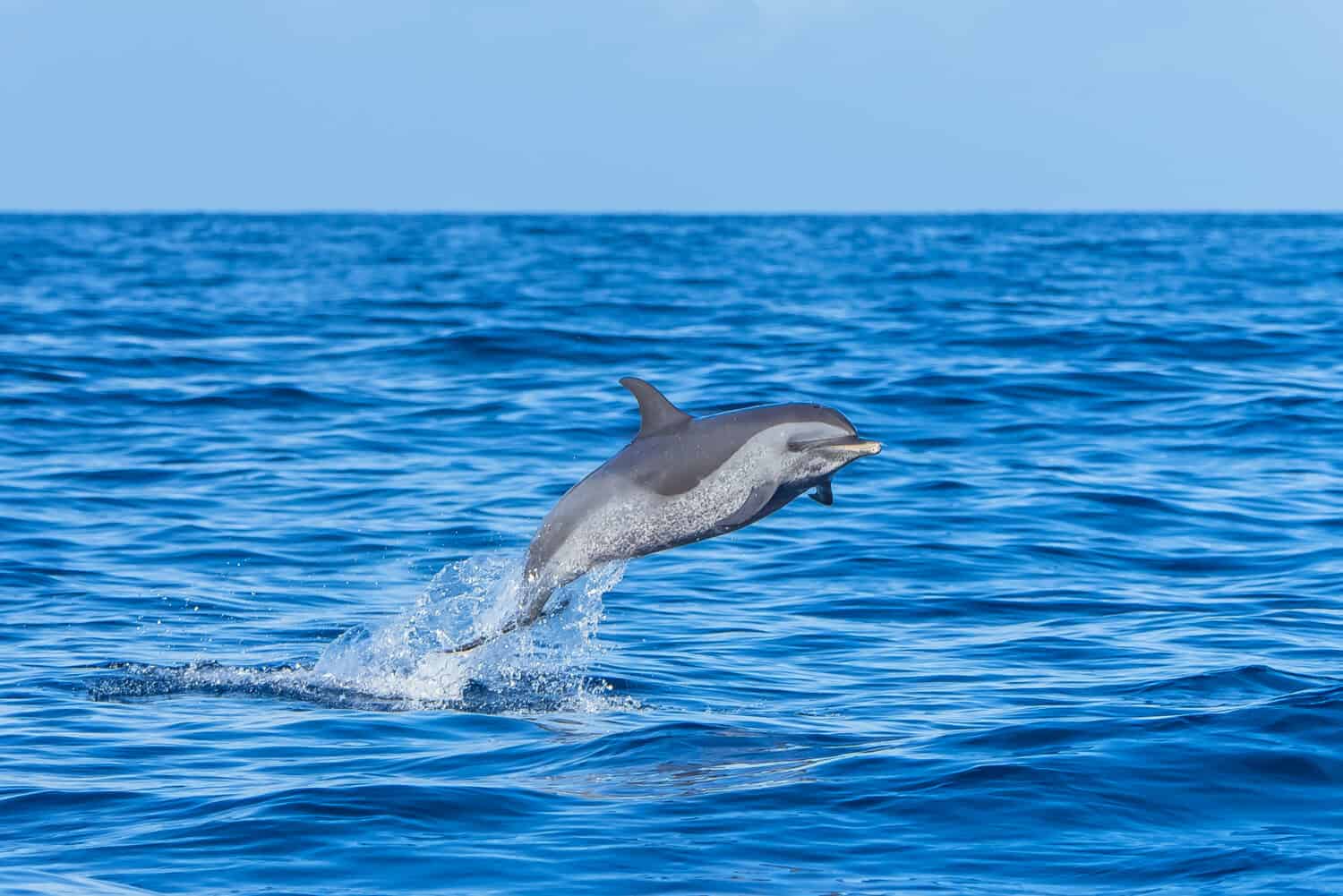
Pantropical spotted dolphins have dark gray or black coloration and spots adorning their bodies, which vary in size and pattern.
©Pascale Gueret/Shutterstock.com
Spinner Dolphins (Stenella longirostris)
Adult spinner dolphins have an average length of about 4 to 8 feet, with males typically larger than females. They possess a slender body and a long, pointed rostrum. These dolphins showcase a beautiful coloration, with a dark gray dorsal side and a lighter gray or white ventral side. Their most remarkable feature is their ability to spin multiple times in the air during leaps, hence their name.
Spinner dolphins have a sociable nature and an affinity for forming large pods. These pods can consist of several dozen to even hundreds of individuals. They engage in synchronized swimming and display remarkable agility during their playful antics. These dolphins also use vocalizations and body movements to communicate and coordinate their activities.
In terms of conservation status, spinner dolphins are listed as a species of “least concern” by the IUCN. However, they still face threats such as habitat degradation, entanglement in fishing gear, and disturbance caused by human activities. Protecting their habitats, promoting responsible marine tourism practices, and respecting their need for undisturbed resting areas are crucial for their long-term well-being.
Spinner dolphins hold a special place in the hearts of Hawaiians and visitors alike. Their mesmerizing spinning leaps and playful nature are true examples of the ocean’s wonders. The opportunity to witness these incredible dolphins in the tropical waters of Hawaii is a truly unforgettable experience.
When and Where to See Spinner Dolphins in Hawaii
You can find Spinner dolphins in Hawaiian waters throughout the year, making them a regional resident species. These charismatic dolphins are known for their diurnal habits, meaning they are most active during the daytime. They spend their nights feeding in deeper offshore waters and return to the nearshore areas during the day to rest, socialize, and engage in their captivating spinning leaps.
You can encounter Spinner dolphins in various locations around the Hawaiian Islands, with their presence spanning the coastlines of Maui, Oahu, Kauai, and the Big Island. You are most likely to encounter them in the morning hours, providing an enchanting start to the day for lucky observers. Shallow bays and protected areas serve as ideal resting spots for these dolphins.

Spinner dolphins have a dark gray dorsal side and a lighter gray or white ventral side.
©Christopher Berthelot/Shutterstock.com
Rough-Toothed Dolphin (Steno bredanensis)
Adult rough-toothed dolphins have an average length of about 6.5 to 9.5 feet. They have a sleek and streamlined body, displaying a dark gray or black coloration. The name “rough-toothed” refers to the distinctive ridges found on their teeth, thought to be an adaptation for capturing and consuming their prey.
Rough-toothed dolphins are whales found in Hawaiian waters that possess several unique characteristics. They have a long, slender beak and a prominent melon on their forehead. Known for their social behavior, they often travel in pods consisting of several individuals. They are highly acrobatic and can exhibit leaping, riding waves, and engaging in synchronized swimming.
The IUCN currently lists the conservation status of rough-toothed dolphins as “least concern.” Like all marine species, they face potential threats.
While sightings of rough-toothed dolphins in Hawaiian waters may be more common than other whales, that doesn’t make encounters with them any less unique for lucky observers. Their presence highlights the rich marine diversity that graces the Hawaiian archipelago.
When and Where to See Rough-Toothed Dolphins in Hawaii
Rough-toothed dolphins reside in Hawaiian waters year-round, making them a resident species in the region. You can spot these mysterious creatures in the deeper offshore waters in small groups. Their presence in Hawaiian waters is due to being attracted to the warm tropical climate and the availability of food sources.
When encountered, you can typically find rough-toothed dolphins in the deeper offshore waters surrounding the Hawaiian Islands. They inhabit areas near oceanic banks, ledges, and slopes. Their preference for offshore environments makes sightings comparatively less common than other dolphin species.

Rough-toothed dolphins are year-round residents of Hawaiian waters.
©Cory Fults/Shutterstock.com
The Importance of Whale Conservation
Conservation efforts in Hawaiian waters dedicate to protecting the diverse and magnificent whales that call this region home. Various conversationalist entities have installed various initiatives and regulations to ensure the well-being and preservation of these incredible creatures.
One of the vital conservation efforts is establishing marine protected areas (MPAs) and sanctuaries. These areas serve as safe havens for whales and other marine species, providing them with protected habitats where they can feed, breed, and raise their young without disturbances from human activities. For example, established in 1982, the Hawaiian Islands Humpback Whale National Marine Sanctuary serves to protect humpback whales during their winter breeding and calving season.
Speed limits and designated vessel approach regulations are in place to reduce the risk of vessel strikes, which can be detrimental to whales. Vessels are required to maintain a safe distance from whales, typically 100 yards, to avoid causing disturbances or potential harm to these marine giants.
Pollution
Pollution is another major issue at stake. One of the major forms of pollution that affects whales is marine debris, mainly plastic pollution. Plastic waste, such as bags, bottles, and fishing gear, can entangle whales, leading to injuries, restricted movement, and even death. Ingestion of plastics can also occur, causing digestive system blockages, malnutrition, and long-term health issues. Efforts are underway to reduce single-use plastics, promote recycling, and conduct regular beach cleanups to prevent plastic pollution from entering the oceans.
Chemical pollution is a significant concern. Harmful substances, such as heavy metals, pesticides, and industrial chemicals, can accumulate in the bodies of whales through bioaccumulation and biomagnification. These pollutants can disrupt the whales’ endocrine and reproductive systems, impair immune function, and deteriorate overall health. Regulations and monitoring programs aim to reduce the release of these toxic substances into the environment and mitigate their impact on marine life.
Noise pollution is a growing concern for whales in Hawaiian waters too. Underwater noise from shipping, seismic exploration, and military activities can interfere with their communication, feeding, and navigation abilities. Whales rely on sound for various essential behaviors, including finding mates and locating prey. Ongoing efforts to establish quiet zones, regulate vessel traffic, and promote quieter technologies to minimize the adverse effects of noise pollution on whales.
The Purpose of Conservation
Regarding specific whales found in Hawaiian waters, some are more at risk than others. For instance, the North Pacific right whale is one of the most endangered whale species in Hawaiian waters. The IUCN lists it as an endangered species. Conservation efforts for this species focus on habitat protection, reducing entanglement risks, and minimizing human disturbances.
Conservation efforts focus on raising awareness about the harmful effects of pollution, promoting responsible waste management practices, and advocating for sustainable policies. Collaborative research, monitoring programs, and public engagement initiatives are essential in identifying pollution sources, implementing effective mitigation strategies, and fostering a sense of stewardship toward the marine environment.
Overall, the conservation initiatives aim to preserve whales’ habitats, food sources, and migratory routes. Conservationists and governing bodies strive to ensure the long-term survival and thriving populations of these magnificent creatures by protecting their environments, regulating human activities, and promoting responsible whale-watching practices.
Individuals need to adhere to guidelines and regulations in place to protect whales. This effort includes maintaining safe distances, reducing various kinds of pollution, and promoting sustainable tourism practices. Education and public awareness campaigns play a vital role in encouraging responsible behavior and fostering a deeper appreciation for the conservation of whales and their habitats.
Conservation is an ongoing effort that requires collaboration among scientists, government agencies, conservation organizations, and the public. By working together and implementing effective management strategies, we can safeguard the future of whales and ensure their continued presence in the Hawaiian waters for generations to come.
Thank you for reading! Have some feedback for us? Contact the AZ Animals editorial team.







